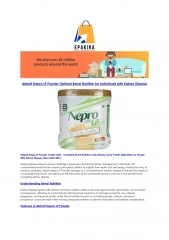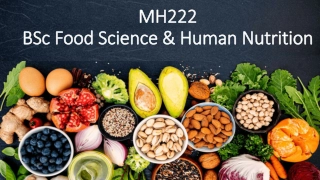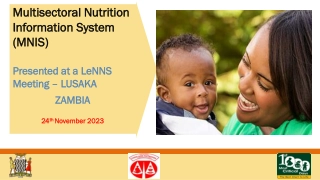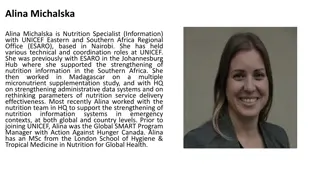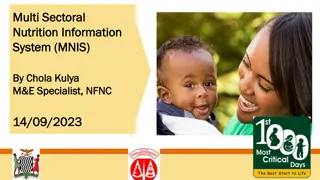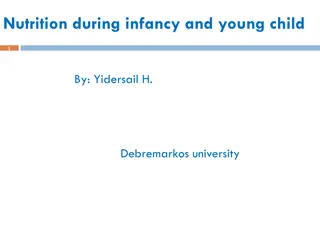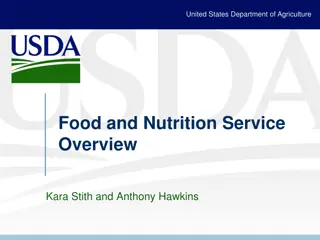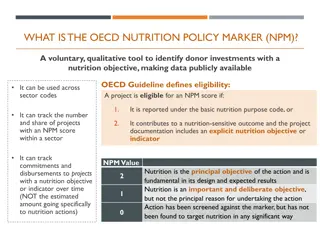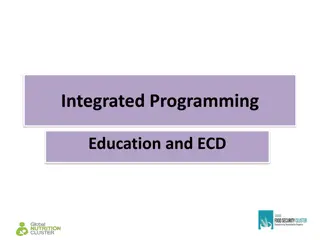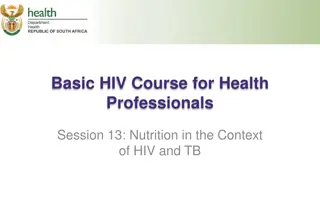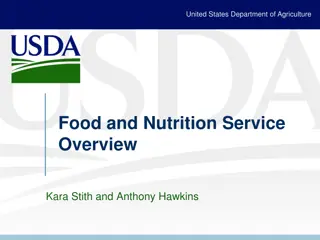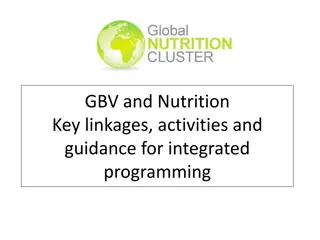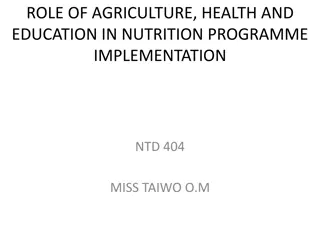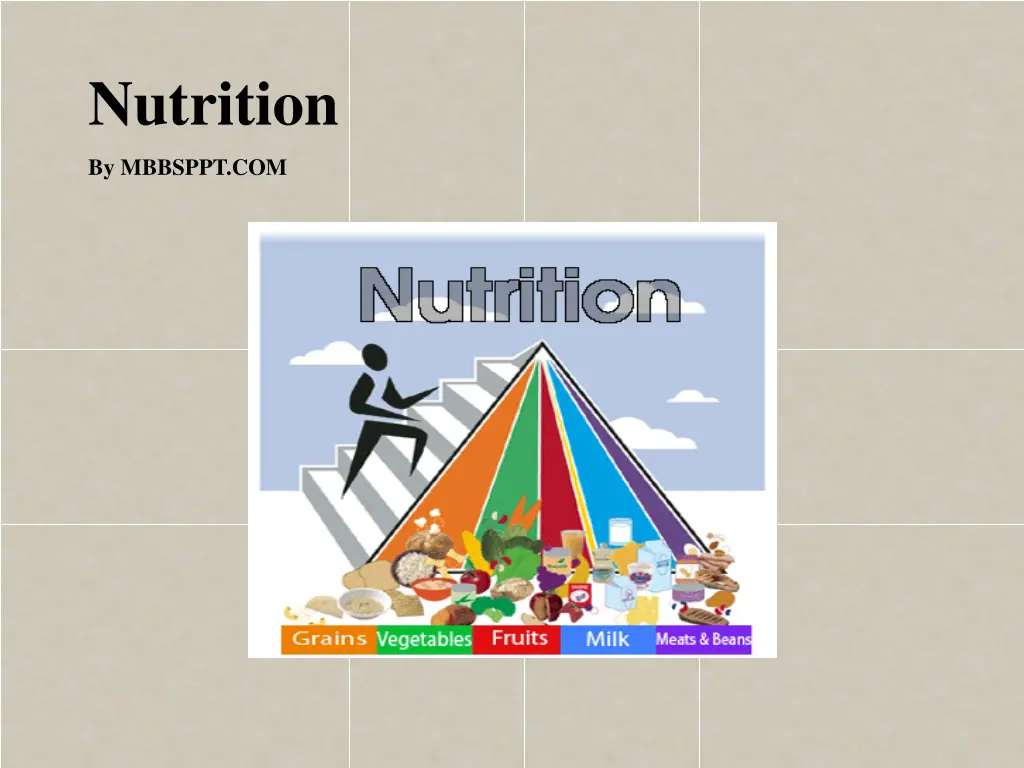
Understanding Nutrition: Essential Components for Optimal Health
Learn about the classifications of macronutrients and micronutrients, recommended daily allowances, formulas for calculating calorie needs, and the impact of carbohydrates and proteins on the body. Discover the importance of biological value and protein efficiency ratio in different protein sources.
Download Presentation

Please find below an Image/Link to download the presentation.
The content on the website is provided AS IS for your information and personal use only. It may not be sold, licensed, or shared on other websites without obtaining consent from the author. If you encounter any issues during the download, it is possible that the publisher has removed the file from their server.
You are allowed to download the files provided on this website for personal or commercial use, subject to the condition that they are used lawfully. All files are the property of their respective owners.
The content on the website is provided AS IS for your information and personal use only. It may not be sold, licensed, or shared on other websites without obtaining consent from the author.
E N D
Presentation Transcript
Nutrition By MBBSPPT.COM
Nutritions are constituents in the food which should be supplied in adequate amt. for optimal growth. Classifications: Macronutrients - need in large amt. by the body. Carbohydrates Proteins Fats Micronutients need in small amt. Vitamins & minerals
On basis of function Energy yielding foods- carb. & fats Bodybuilding foods- proteins Protective foods- vit. & minerals Recommended daily allowance (RDA)- nutrient intake considered adequate to meet the known nutrient needs of practically all healthy children in a particular age.
Holliday- Segar formula for calculating the daily requirement of calories Wt. in kg Daily req. of calories ( kcal/kg) < 10 100 10- 20 1000 + 50 > 20 1500 + 20 ICMR recommendations Age Calories (kcal/kg/d) Protein (g/kg/d) 0-3 mo 120 2.2 4-6 mo 115 1.8 6-9mo 110 1.8 9-12mo 105 1.5 1 yr 100 1.5 2-3 yrs 120 1.4 4-6yrs 80-90 1.3 7-9 yrs 70- 80 1.2 10-12 yrs 60-70 1.2
Carbohydrates 55% of total calorie Monosaccharides- glucose, fructose, galactose Disaccharides- lactose, maltose, sucrose Polysaccharides- starch, dextrins, glycogen, pectin Glycaemic index effect of carb. on the blood glucose levels. High GI- raise blood glucose rapidly Low GI raise blood glucose slowly hence less fluctuation on insulin Dietary fibres- non starch polysaccharides., donot have any calories value, help in digestion. Eg- cellulose, lignins, pectins etc
Proteins 20 aminoacids 12 non essential a.a 8 essential a.a Biological value (BV)- fraction of retained nitrogen compared to the absorbed nitrogen. BV= retained nitrogen/ absorbed nitrogen X 100 Protein efficiency ratio ( PER)- define a the gain in wt. per unit wt. of prot. consumed over a pd. of time.
BV of various protein Source of prot. BV Egg 96-100 Cow milk 90 Rice 77 Fish 75 Meat 74 Wheat 66 Bengal gram 74 PER Source of prot. PER Egg 3.8 Fish 3.5 Meat 3.2 Cow milk 2.8 Rice 1.7 Wheat 1.3 Bengal gram 1.1
Digestibility Coefficient (DC) amt. of absorbed nitrogen compared to nitrogen present in the food DC= absorbed nitrogen/ food nitrogen X 100 Net prot. Utilization (NPU) amt. of retained nitrogen to the nitrogen present in the food item. It the product of BV & DC NPU= retained nitrogen/ food nitrogen X100 NPU= BV X DC
NPU Source of Prot. NPU Egg 96 Cow milk 85 Rice 77 Meat 76 Fish 74 Bengal gram 61 Wheat 61
Fatty acids- saturated , monounsaturated, polyunsaturated. Source Animal source-ghee, butter, egg yolk, cheese etc Plant mustared oil, nuts, vegetable oils EFA- is a polyunsaturated fatty acid need in the diet. Eg- omega-6 ( linoleic acid), omega 3 ( linolenic acid). EFA 3% of total energy requirement of the child.
EFA in various edible oils ( g/100g) Oil Total EFA Linoleic Linolenic Safflower 74.5 74 0.5 Soya bean 57 52 5 Sunflower 52 52 trace Ground nut 28.3 28 0.3 Coconut 2.2 2.2 nil Ghee 2.1 1.6 0.5
Balanced diet Carb.- 55%- 60% (1g=4kcal) Fat- 30%- 35% (1g=9kcal) Protein- 10%-15% (1g=4kcal) Ratio of prot. derived from cereals to pulse should be 4:1 Minimum level of leafy & other vegetables should not be less than 150g/day Cereal defecient of lysine, threonine , tryptophan. Pulses rich in lysine & defecient in methionine
Calorie & protein content of common food Food category Food stuff Amount Calorie ( kcal) Protein (g) Cereals Rice 100g 325 7.5 Wheat 100g 341 12.1 Maize 100g 340 11 Barley 100g 335 9-11 cornflour 100g 360 8.6 Bread (white) 1 slice 50-70 2 Pulses Dhal 100g 372 P21, C60 Soya bean 100g 432 43.2 Bengal gram 100g 360 17 Green gram 100g 340 24 Red gram 100g 335 22.5 Black dhal 100g 347 P24, C55 Milk & milk products Breast milk 100ml 65 1.1 Cow milk 100ml 70 3.5 Fats & oil butter 100g 730 0 Veg oil 100g 900 0
Food category Food stuff Amount Calorie ( kcal) Protein (g) Nut Coconut 100g 444 4.5 Almond 100g 655 20 Ground nut 100g 560 27 Meat & poultry Egg 1 66-80 6 Mutton 100g 194 18.5 Chicken 100g 300 18 Liver (goat) 100g 107 20 Beef 100g 400 8 pork 100g 114 18.7 Fish 100g 100-300 20-60 Sugar 1 tsf 16.0 C-4.2, F-0, P-0 Rajma C-60, F-1.3 100g 346 22
Malnutrition Indicators Wt/age Ht./age Wt./ ht Calculation & interpretation- Wt. for age= wt. of the child/ wt. of normal child of same age X 100 Indicator Acute malnutrition Chr. malnutrition W/A (underweight) low low H/A( stunting) N low W/H ( wasting) low N
Classification IAP Classification:- Nutrition status Wt. for age (%) Normal >80 Grade I PEM 71-80 Grade II PEM 61-70 Grade III PEM 51-60 Grade IV PEM <50 Welcome Trust Classification Wt. for age Odema present Odema absent 60 %- 80% kwashiorkor undernutrition < 60% Marasmic kwashiorkor marasmus
Gomez Classification Nutritional status Wt. for age Normal >90 I degree PEM ( mild) 76-90 II degree PEM ( moderate) 60-75 III degree ( severe) <60 WHO Classification parameter Moderate undernutrition Severe undernutrition Symmetrical odema Absent Present Wt. for ht. Z score or SD score between -2 & -3 Z score or SD score between < -3 Ht. for age Z score or SD score between -2 & -3 Z score or SD score between < -3
Waterlow classification ( Ht. for age) Classification Ht. for age (%) Normal >95 First degree stunting 90-95 Second degree stunting 85-89 Third degree stunting <85 Waterlow classification ( Wt. for Ht.) Classification Ht. for age (%) Normal >90 Mild wasting 80-90 Moderate wasting 70-79 Severe wasting <70
Age independent criteria Midarm circumference (1-5yr) Bangle test, Shakir s tape Skinfold thickness (1-6yr)- biceps, triceps, infrascapular, suprailiac Harpenden caliper >10 mm- normal <6mm- abnormal Kanawati index= Rao & Singh s index= wt.(kg)/ (ht. in cm) X 100 Dugdale sindex= wt. in kg/ (ht. in cm) X 100 Ponderal index= wt in g X 100/ ht. in cm BMI= wt. in kg/ (ht. in m ) MAC( cm)/ head circumference (cm)
Occasional Signs: Flaky-paint rash Noma Hepatomegaly Clinical Manifestations: Diagnostic Signs Edema Muscle wasting Psychomotor changes Laboratory: Decreased serum albumin EEG abnomalities Iron & folic acid deficiencies Liver biopsy fatty or fibrosis may occur Common Signs Hair changes Diffuse depigmentation of skin Moonface Anemia
Noma Flaky-paint rash
Laboratory Data: 1. Serum albumin N 2. Urinary urea/ crea N 3. Serum essential a.a. index N 4. Anemia uncommon 5. K+ deficiency present 6. Serum cholesterol low 7. Diminished enzyme activity 8. Bone growth delayed 9. Liver biopsy N or atrophic Clinical Manifestations: 1. Wasting 2. Muscle wasting 3. Growth retardation 4. Mental changes 5. No edema 6. Variable-subnormal temp, slow PR, good appetite, often w/diarrhea, etc.
Thiamine, Riboflavin, Niacin, Pyridoxine are cofactors to enzymes in energy metabolism, hence, deficiencies show up in quickly growing tissues such as epithelium. Typical symptoms for the group include: Dermatitis Glossitis Cheilitis Diarrhea Nerve cells use lots of energy, so symptoms also show up in the nervous tissue: Peripheral neuropathy Depression Mental confusion Lack of motor coordination Malaise
Thiamine (Vitamin B1) Deficiency Beriberi Three forms: 1. Wet beriberi: generalized edema, acute cardiac symptoms and prompt response to thiamine administration 2. Dry beriberi: edema not present, condition similar to peripheral neuritis w/ neurological disorders present 3. Infantile beriberi divided into: a. Acute cardiac - ages 2-4 months; sudden onset of cardiac such as cyanosis, dyspnea, systolic murmur & pulmonary edema w/ rales b. Aphonic - ages 5-7 months; insidious onset of hoarseness, dysphonia or aphonia c. Pseudomeningeal - ages 8-10 months; signs of meningeal irritation apathy, drowsiness & even unconsciousness. Treatment: 1. Children: 10mg p. o. daily for several weeks 2. Adults 50mg
Riboflavin (Vitamin B2) Deficiency Functions: 1. Acts as coenzyme of flavoprotein important in a. a., f. a. & CHO metabolism & cellular respiration Needed also by retinal eye pigments for light adaptation 2. Clinical Manifestations: 1. Characteristic lesions of the lips, the most common of which are angular stomatitis and cheilosis 2. Localized seborrheic dermatitis of the face may result such as nasolabial seborrhea or dyssebacia and angular palpebritis 3. Scrotal or vulvar dermatosis may also occur 4. Ocular s/sx are photophobia, blurred vision, itching of the eyes, lacrimation & corneal vascularization Treatment: 1. 2. Riboflavin 2-5mg p. o. daily w/ increased B complex Parenteral administration if relief not obtained
Niacin (Vitamin B3) Deficiency Pellagra Etiology: 1. 2. 3. Clinical Manifestations: 1. Start w/ anorexia, weakness, irritability, numbness & dizziness 2. Classical triad of dermatitis, diarrhea & dementia 3. Dermatitis may develop insidiously to sunlight or heat a. First appears as symmetrical erythema b. Followed by drying, scaling & pigmentation w/ vesicles & bullae at times c. Predilection for back of hands, wrists, forearms (pellagrous glove), neck (Casal s necklace) & lower legs (pellagrous boot) 4. GIT s/sx are diarrhea, stomatitis or glossitis; feces pale, foul milky, soapy or at times steatorrheic 5. Mental changes include depression, irritability, disorientation, insomnia & delirium Diets low in niacin &/or tryptophan Amino acid imbalance or as a result of malabsorption Excessive corn consumption
Treatment Niacin 50-300mg daily which may be taken for a long time Skin lesions may be covered w/ soothing lotions
Pyridoxine (Vitamin B6) Deficiency Functions: 1. Vitamin B6 is involved in the synthesis and catabolism of amino acids, synthesis of neurotransmitters, porphyrins and niacin 2. Plays important role in clinical conditions such as anemia, hyperemesis gravidarum, cardiac decompensation, radiation effects, skin grafting, INH therapy & seborrheic dermatitis Etiology: 1. Losses from refining, processing, cooking & storing 2. Malabsorptive diseases such as celiac disease may contribute 3. Direct antagonism might occur between INH & pyridoxal phosphate at the apoenzyme level
Clinical Manifestations: 1. Three different types a. Neuropathic, due to insufficient neurotransmitter synthesis, such as irritability, depression & somnolence b. Pellagrous, due to low endogenous niacin synthesis, such as seborrheic dermatitis, intertrigo, angular stomatitis & glossitis c. Anemic, due to low porphyrin synthesis, such as microcytic anemia & lymphopenia 2. In genetic diseases involving pyridoxal phosphate enzymes also xanthurenic aciduria, cystathioninuria & homocystinuria Treatment: 1.Pyridoxine 100mg IM injection for seizures due to deficiency 2.Children w/ pyridoxine dependency should be given 2-10mg IM injection or 10-100mg oral vitamin B6
Folic Acid (Vitamin B9) Deficiency Functions: 1.Needed for RBC & DNA formation, cell multiplication esp. GI cells 2.Newly discovered functions: a.Prevents neural tube defects b.Prevents heart disease (reduces homocysteine levels) c.Prevents colon cancer Etiology: Peak incidence 4-7 months Deficient dietary intake: goat s milk deficient & powdered milk poor source Deficient absorption as in celiac disease, achlorhydria, anticonvulsant drugs, zinc deficiency & bacterial overgrowth Impaired metabolism w/ ascorbic acid deficiency, hypothyroidism, drugs like trimethoprim & alcoholism Increased requirement during rapid growth & infection Increased excretion/loss may occur subsequent to vitamin B12 deficiency & chronic alcoholism Increased destruction possible in cigarette smoking
Clinical Manifestations: 6. Formiminoglutamic acid in urine esp after oral histidine 7. Serum LDH markedly high 8. Bone marrow hypercellular RDA: 20-50mcg/24 hrs 1.Megaloblastic anemia w/ irritability, failure to gain wt & chronic diarrhea 2.Thrombocytopenic hemorrhages advanced cases 3.Scurvy may be present Treatment: 1. Parenteral folic acid 2-5mg/24 hrs, response in 72 hrs, therapy for 3-4 wks 2. Transfusions only when anemia severe 3. Satisfactory responses even w/ low doses of 50mcg/24 hrs, have no effect on primary vitamin B12 deficiency 4. If pernicious anemia present, prolonged use of folic acid should be avoided Laboratory Findings: 1.Anemia macrocytic 2.Serum folic acid <3ng/ml, normal level=5-20ng/ml 3.RBC folate levels indicator of chronic deficiency, normal level=150-600ng/ml 4.Serum iron & vitamin B12 normal or elevated
Cobalamine (Vitamin B12) Deficiency Absorption: Vitamin B12 + glycoprotein (intrinsic factor) from parietal cells of gastric fundus terminal ileum absorption + intrinsic factor + Ca++ blood Function: Needed in reactions affecting production of methyl groups Etiology: Congenital Pernicious Anemia: Lack of secretion of intrinsic factor by stomach manifest at 9 months-10 years as uterine stores become exhausted Inadequate intake or dietary deficiency rare 1. Strict vegetarian diet 2. Not commonly seen in kwashiorkor or marasmus 3. Breast-fed infants whose mothers had deficient diets or pernicious anemia Consumption or inhibition of the B12-intrinsic factor complex Vitamin B12 malabsorption from disease of ileal receptor sites or other intestinal causes
Clinical Manifestations: 1. Megaloblastic anemia that becomes severe 2. Neurological includes ataxia, paresthesias, hyporeflexia, Babinski responses, clonus & coma 3. Tongue smooth, red & painful Laboratory Findings: 1. Anemia macrocytic 2. Serum vitamin B12 <100pg/ml but serum iron & folic acid normal or elevated 3. Serum LDH activity markedly increased 4. Urinary excess of methylmalonic acid, a reliable & sensitive index RDA: Infants 0.5 mcg/day Older children & adults 3mcg/day Treatment: 1. Prompt hematological response w/ parenteral vitamin B12 1-5mcg/24hrs 2. If there is neurological involvement 1mg IM daily for at least 2wks 3. Pernicious Anemia: Monthly vitamin B12 1mg IM necessary throughout patient s life
Ascorbic Acid (Vitamin C) Deficiency Scurvy Functions: 1. Collagen is the major connective tissue in the body & hydroxyproline, found only in collagen, is formed from proline requiring ascorbic acid If there is defective collagen formation, endochondral bone formation stops , intercellular substance is no longer formed 2. 3. Vitamin C is involved in hydroxylation reactions in the synthesis of steroids and epinephrine 4. Ascorbic acid also aids iron absorption by reducing it to ferrous state in the stomach, spares vitamin A, vitamin E and some B vitamins by protecting them from oxidation, and enhances the utilization of folic acid by aiding the conversion of folate to tetrahydrofolate Etiology: More common 6-24 months May develop in breastfed infant if mother s diet deficient Improper cooking practices produce significant nutrient losses & faulty dietary habits
Clinical Manifestations: 1. Early stages are vague symptoms of irritability, digestive disturbances & anorexia Mild vitamin C deficiency signs include ecchymoses, corkscrew hairs and the formation of petechiae due to increased capillary fragility resulting from weakened collagen fibrils Severe deficiency results in decreased wound healing, osteoporosis, hemorrhaging, bleeding into the skin and friable bleeding gums with loosened teeth A presenting feature is an infant w/ painful, immobile legs (pseudoparalysis), edematous in frog position & occasionally w/ mass There is depression of sternum rosary of scorbutic beads at the costochondral junction due to subluxation of the sternal plate Orbital or subdural hemorrhages, melena & hematuria may be found Low grade fever & anemia usually present Impairment of growth & development 2. 3. 4. 5. 6. 7. 8.
Diagnosis: 1. 2. 3. 4. History of vitamin C-deficient diet Clinical picture Therapeutic test X-ray findings in the long bones: a. Most prominent & early change is simple knee atrophy b. Shaft trabeculae cannot be distinguished giving ground glass appearance c. Cortex reduced to pencil-point thinness d. Zone of well-calcified cartilage, white line of Fraenkel, seen as irregular & thickened white line w/c e. Zone of rarefaction, a linear break in bone proximal & parallel to white line under at metaphysis f. Calcifying subperiosteal hemorrhages cause bone to assume a dumb- bell or club shape
Differential Diagnosis: 1. Bleeding, swollen gums: Chronic gingivitis & pyorrhea w/ pus & respond to good dental hygiene 2. Pseudoparalysis: Syphilis negative x-ray; Poliomyelitis absent tenderness of extremities 3. Tenderness of limbs: RF age >2 yrs; Suppurative arthritis & osteomyelitis positive blood cultures 4. Bleeding manifestations: Blood dyscracias positive blood exams 5. Rosary of scorbutic beads : Rickets
Prognosis: 1.Recovery rapid w/ adequate treatment & permanent deformity rare 2.Pain ceases in a few days but swelling caused by subperiosteal hemorrhages may last several months Prevention : 1.A minimum daily intake of 30mg is recommended by WHO for all age levels. 2.Every infant should receive supplement starting 2nd week of life. 3.Lactating mothers should have at least 50mg vitamin C daily. 4.Guava & papaya richer in vitamin C than citrus fruits, also in most green leafy vegetables, tomatoes & fresh tubers but absent in cereals, most animal products & canned milk. Treatment: Ascorbic acid 200-500mg daily or 100-150ml of fruit juice.
Be master of your habits, Or they will master you

